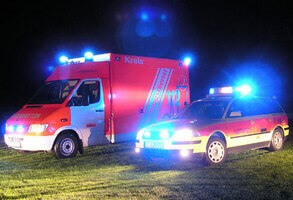
Why hypnosis helps with anxiety and depression
2. July 2017
Frei von Flugangst mit Hypnose
6. March 2018Often the very mention of hypnosis causes the famous raised eyebrow in many people – they think of hypnosis shows or exaggerated (and completely inaccurate) portrayals of hypnosis in film and television.
And now I’m talking about hypnosis in emergency services, too?
In fact, hypnosis was already approved as a psychotherapeutic procedure by the German Scientific Advisory Board for Psychotherapy in 2006, and in 2013 firefighters in France were trained in hypnosis for the first time and were thrilled.
And the use of hypnosis in emergency situations is nothing new at all: as early as 1976, an American
Psychiatrist (Erik Wright) conducted the experiment known as the “Kansas Experiment.”
In doing so, a study group was given the following three instructions:
- The patient should be removed from the scene of the accident and from the crowd as quickly as possible
- No petty or negative conversation should be engaged in
- One should read a standardized text with positive suggestions repeatedly in a calm voice to the emergency patient (whether unconscious or not):
“The worst is over. We will now take you to the hospital, where everything is already prepared.
Your body can now focus entirely on its self-healing powers, while you can now feel completely secure. Let all your organs, your heart, your blood vessels, yourself get into a condition that will ensure your survival and rapid healing. Bleed just enough to clean your wounds, and then let your vessels close on their own to the point that your life is secure.
Your bodily functions, your body temperature, everything is maintained optimally while everything is already being prepared in the hospital for your optimal care.
We will get you there as quickly and safely as possible.
You are now safe.
The worst is over.”
This rather unspectacular text has been shown to result in more patients reaching the hospital alive, more patients surviving overall, and survivors also recovering more quickly. Despite these promising results, the approach of using hypnosis more in rescue services unfortunately disappeared again for the most part.
With just a few encouraging exceptions like the training in hypnosis techniques of the Alsatian firefighters in the video above. Or the use of hypnosis in mountain rescue in Carinthia, Austria, since 2011, as well as several hypnosis concepts for rescue and emergency situations can be found in Switzerland.
But it is also important to know that each individual with the above words is equally capable of providing great help in an emergency, possibly even saving lives.
People in emergency situations experience stress, anxiety, perhaps pain or shortness of breath, and feel acutely threatened by illness, injury, death, as well as the possibility of becoming permanently disabled. That is why such people often go into a so-called “problem trance” in this situation: they have a focused attention, relate everything to themselves and are extremely receptive to suggestions – whether positive or negative.
That is why badly chosen words can cause great damage (e.g. when an excited paramedic says “He’s going to bleed to death here!”) – but equally, well-chosen words can also do a lot of good here.
Therefore, my request: remember the words described above. And if you ever find yourself in such a situation in any way, help the victim by repeating these or similar words several times in a calm voice. Of course, only after you have administered first aid (if necessary) and called the emergency physician. Afterwards, however, you may be doing the person in question a great service, and you will certainly make the work of the doctors who take over afterwards easier.
Hypnosis helps!
P.S.: By the way, here’s more info and also training on the subject of emergency hypnosis: https://www.notfall-hypnose.de/index.html




